|
|
|
|
|
|
Easier to weld the underside with it still bolted to the head?
If you do it like that,put a bit of shim stock between the head and the manifold to blank off the ports and stop any little balls of weld spatter getting into the engine. 😊
|
| |
Last Edit: May 7, 2020 22:45:54 GMT by Deleted
|
|
|
|
moglite
Part of things
 
Posts: 815  Club RR Member Number: 144
Club RR Member Number: 144
|
|
|
|
The last couple of days have been modifying the exhaust manifold. I think it i is a stainless Double-S one for an MGB. It is a very tight fit on a Farina, there is a simple joint on the 2:1 which makes fitting very difficult 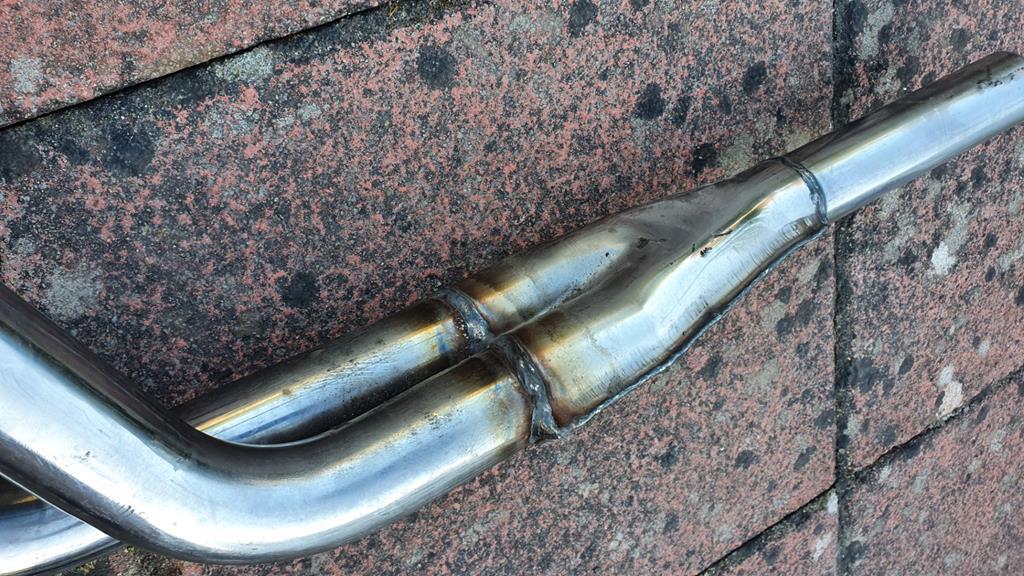 So cut the edges off and re-weld it, and it is now 15mm narrower. Which isn't a lot, but it means the manifold now slides straight on rather than having to loosen the engine mounts, and lever the engine over. Very worthwhile. 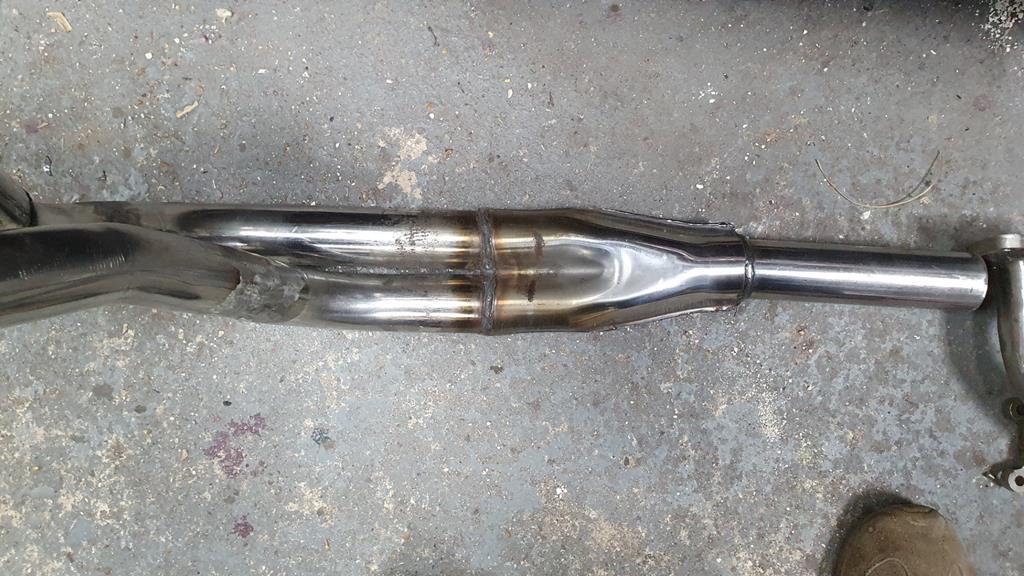 But the teaser picture - I wasn't expecting Bōsōzoku ( yes I had to look up the spelling) but some high mount turbo. Alas a lot more tedious than that. The manifold hung a little too low. On a regular-ish Farina this wouldn't be a problem, but slammed on air-springs - I needed it about an inch higher. I've got limited experience of working with stainless, but I know that the thin pipes of the manifold will twist and curl like an action man in a deep fat fryer when the welder is applied !! The trick is to hold the manifold square and true, whilst I cut it apart and re-weld it. Build an MDF jig, add loads of index marks, and get ready to cut the manifold apart. 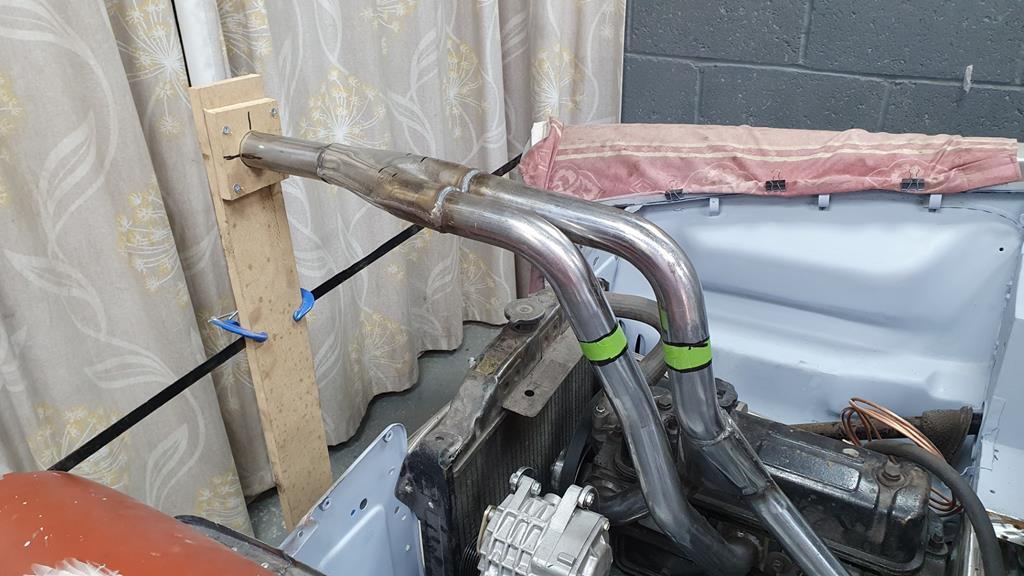 Cut the manifold, and also cut the MDF template so it sits an inch lower - that was the genius touch  I just joined the rear most pipe, and that was my datum. The front pipe of course was never going to line up, so cutting out another inch of pipe and putting in a small section seemed to work well. 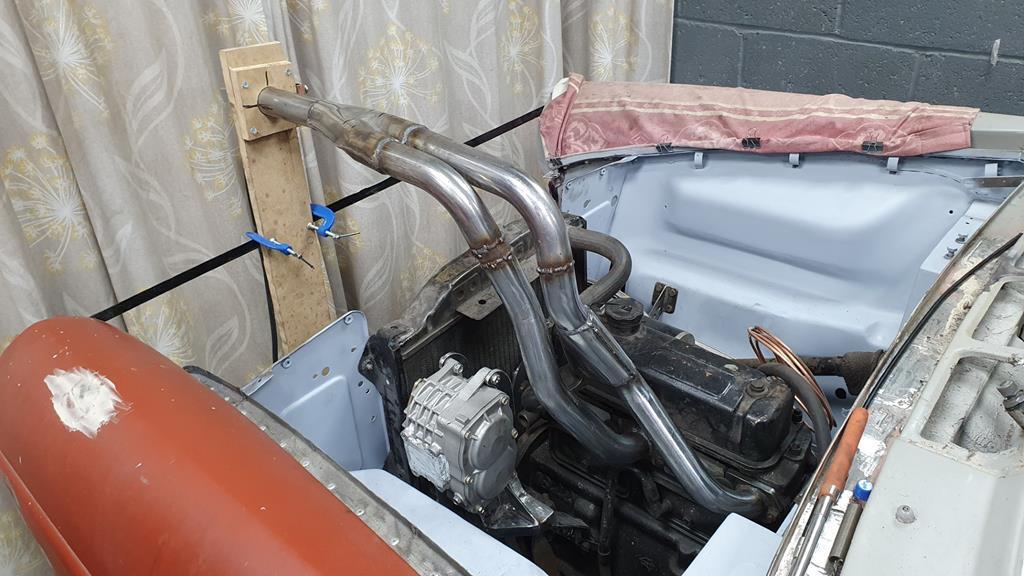 Here is the manifold with the welds roughly cleaned up. Where they sit, they really can't be seen that easily.  But a big tick in the box The manifold is now easy to fit It stills at the right height, ready for the rest of the exhaust. Brilliant - now ready to bolt back on the right way up  |
| |
1967 Morris Oxford Traveller
1979 Toyota LandCruiser BJ40
1993 Daimler Double Six
2007 Volvo XC70 2.4D
|
|
moglite
Part of things
 
Posts: 815  Club RR Member Number: 144
Club RR Member Number: 144
|
|
|
|
Ahhh some of that Bukkake style or whatever it’s called. Brilliant - just for the family friendly aspect of this forum, I must warn you not to google Bukkake, or indeed plasterers radio  |
| |
1967 Morris Oxford Traveller
1979 Toyota LandCruiser BJ40
1993 Daimler Double Six
2007 Volvo XC70 2.4D
|
|
|
|
|
|
|
|
I like how that car on the left has thoughtfully run the exhaust between the rear seats to keep passengers warm. As if fluffy seats wasn't enough.
I was hoping for exhaust turbo poking out of the bonnet, but hey.
|
| |
|
|
|
|
|
|
|
When building custom motorcycles at the shop years ago, I treated the insides of all tanks before they hit the road. With many products on the market, all claiming to be the permanent solution, but not willing to risk failure on clients rides, I visited the airport, found the time proven product and procedure they used, and that was what we used at the shop. Decades later..., I'm still in touch with several client friends who are still riding the same bikes with never an issue of the product seperating from the tank wall, with insides of tanks still looking flawless. The same can't be said for many of the other products of the day, and I've heard of tank sealant failures of some of the current "hot" products.... Just a thought, Lance But, what is it? and is it available to the all of us? Bob, This was decades ago and much has changed in the world of chemistry since then, companies fold, are bought out, product lines reformulated for any number of reasons, etc., so even if a product by the same name still existed (I've looked, but haven't found it), chances are it would not be formulated as it was in the past. Had I a need for reliable tank sealant today, I'd again talk to mechanics and builders of small airplanes to learn what they recommend for currently available products, study up on those and choose what best suited my application. My post was some time ago, but I seem to recall Chris, Mark, perhaps others chiming in with modern tank sealants they thought highly of. Research those. Happy hunting, Lance |
| |
|
|
|
|
|
|
|
But, what is it? and is it available to the all of us? Bob, This was decades ago and much has changed in the world of chemistry since then, companies fold, are bought out, product lines reformulated for any number of reasons, etc., so even if a product by the same name still existed (I've looked, but haven't found it), chances are it would not be formulated as it was in the past. Had I a need for reliable tank sealant today, I'd again talk to mechanics and builders of small airplanes to learn what they recommend for currently available products, study up on those and choose what best suited my application. My post was some time ago, but I seem to recall Chris, Mark, perhaps others chiming in with modern tank sealants they thought highly of. Research those. Happy hunting, Lance The product you need is this: www.frost.co.uk/por15-car-bike-motorcyle-fuel-tank-repair-sealer-946ml/Or they do a kit www.frost.co.uk/por15-basic-big-fuel-car-tank-repair-sealer-kit/Both come in various sizes Tried & tested over several projects over the last decade without issue - resists modern ethanol based fuels - the key to making it work effectively is preparation - the fuel tank must be thoroughly cleaned & dried prior to application Apologies to moglite for the slight thread deviation  |
| |
Last Edit: May 8, 2020 7:46:03 GMT by Deleted
|
|
|
|
|
|
|
|
Ok, so I was sort of right, but not the sort of right I thought I meant. Boring, but not boring.
|
| |
Last Edit: May 8, 2020 9:01:46 GMT by bmcnut
|
|
moglite
Part of things
 
Posts: 815  Club RR Member Number: 144
Club RR Member Number: 144
|
|
|
|
Apologies to moglite for the slight thread deviation  No apologies necessary - it is what is in my NOS fuel tank as protection. |
| |
1967 Morris Oxford Traveller
1979 Toyota LandCruiser BJ40
1993 Daimler Double Six
2007 Volvo XC70 2.4D
|
|
moglite
Part of things
 
Posts: 815  Club RR Member Number: 144
Club RR Member Number: 144
|
|
May 11, 2020 14:00:39 GMT
|
Not too much to report despite the long weekend. I spent way too long cleaning up the manifolds for the SuperCharger install. So I could check for pinholes, and then filing/sanding/grinding them tidy. Bolted them back on to keep them out of harms way. I think the final finish for these is going to be powdercoat rather than polished FWIW. With the stainless work done for now, it was time to swap the welder wire back to mild and make a bracket. This beauty picks up on a couple of un-used UNC threads in the block. 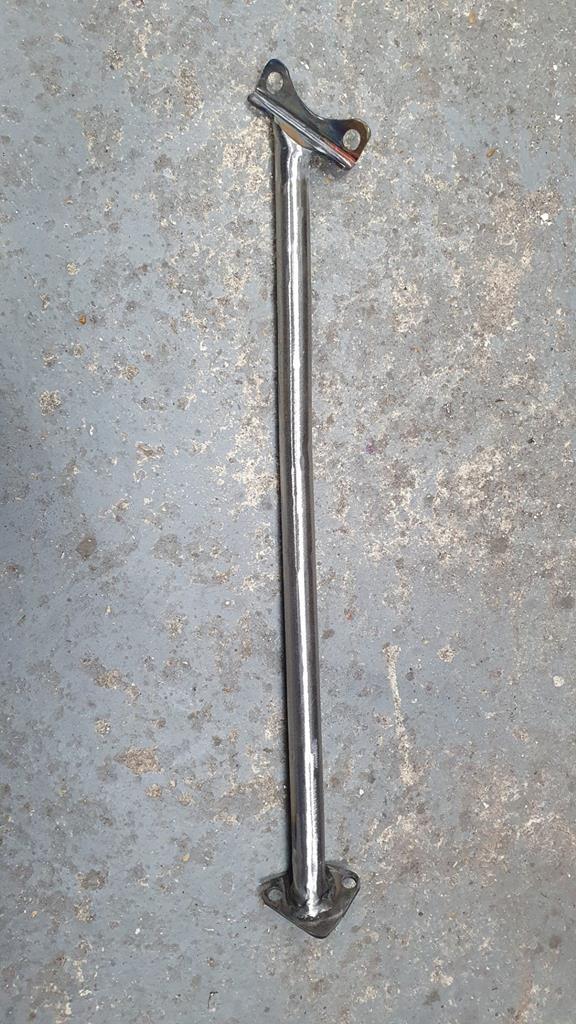 Which then in turn will help support the carb and air-filter 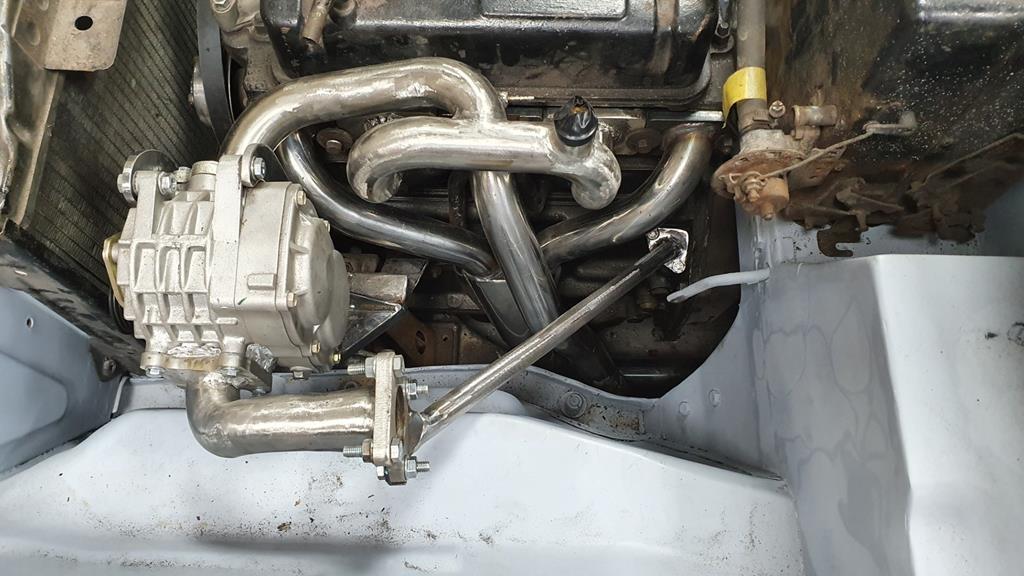 The aforementioned air-filter is a work in progress, and completely custom. But I'm waiting for a shipment from China before I can reveal that. Also been doing a lot of work on the boost gauge, which I'm hoping will be quite spectacular when finished, but again it won't make sense until it is finished. Sorry to be a tease. |
| |
1967 Morris Oxford Traveller
1979 Toyota LandCruiser BJ40
1993 Daimler Double Six
2007 Volvo XC70 2.4D
|
|
|
|
|
|
|
|
Might be waiting a while for anything from China..
Nice bracket.
|
| |
|
|
|
|
|
|
|
|
|
|
What are you doing for a blow off valve for when you take your foot off the throttle?
The country does not need China we managed without them before we can again.
|
| |
|
|
moglite
Part of things
 
Posts: 815  Club RR Member Number: 144
Club RR Member Number: 144
|
|
|
|
What are you doing for a blow off valve for when you take your foot off the throttle? Nothing, that is more turbo technology if I understand it correctly. |
| |
1967 Morris Oxford Traveller
1979 Toyota LandCruiser BJ40
1993 Daimler Double Six
2007 Volvo XC70 2.4D
|
|
|
|
|
|
|
|
Well it's both when you take your foot off the throttle the butterfly shuts but as with a turbo the charger still turns and forces a charge of compressed air to the engine with no where to go and could to damage if it does not have a path of escape, destroying your carb or worse.
|
| |
|
|
moglite
Part of things
 
Posts: 815  Club RR Member Number: 144
Club RR Member Number: 144
|
|
May 15, 2020 10:21:46 GMT
|
Well it's both when you take your foot off the throttle the butterfly shuts but as with a turbo the charger still turns and forces a charge of compressed air to the engine with no where to go and could to damage if it does not have a path of escape, destroying your carb or worse. But a couple of but's  Supercharger is obviously belt driven off of the engine, so as the foot comes off the throttle, the engine slows, and therefore so does the supercharger. My carb is suck through, so it will never see boosted pressure The Moss kit that is sold for MGBs doesn't have a blow off valve, just a pop-off valve which protects against backfires. It is the pop-off valve that I've got mounted vertically on the inlet manifold. Are we on the same page  |
| |
1967 Morris Oxford Traveller
1979 Toyota LandCruiser BJ40
1993 Daimler Double Six
2007 Volvo XC70 2.4D
|
|
|
|
|
May 15, 2020 11:07:06 GMT
|
Yes and no I still think you should put some safety features in place, a suck through is better but that means if you are using an SU or constant depression carb the SC could cause the stay on as the vacuum generated could over come the carb, the moss kit will have been researched and designed to allow for all eventualities as it is being sold as a product not a DIY build as they have to make sure they cannot be held liable for any problems. All I'm saying is put some safety measures in place as strange things happen you would not expect when you pressure charge an engine.
This is the description for the moss kit as you can see it shows they have safety features in place.
www.moss-europe.co.uk/supercharger-system-150-050.html Superchargers have been used on cars and piston engined aircraft since before World War II in order to obtain maximum power without losing vital torque. The Moss supercharger kits give increased torque and horsepower throughout the rev range without adding extra stress to your engine. Our supercharger kits use an Eaton MP45 charger unit that features a by-pass valve. During light throttle conditions this valve remains closed by-passing the compressor, but then opens to feed the charge through the compressor to give maximum power when required. This system gives good drivability and maintains economy during light throttle conditions then boosts the charge the moment the throttle is pressed, giving an instant boost of power. Our engineers designed an intake manifold that provides equal airflow, pressure and fuel mixture to each cylinder. By optimizing the distribution in the manifold for each cylinder, you can run more boost pressure without the chance of harmful detonation. The Moss supercharger system produces 7.5- 8.25 PSI of boost at sea level. Bolted on to a standard engine you may expect a horsepower increase of 40% at the flywheel. Just hold on to the steering wheel when you decide to press the pedal! The kits include an MP45 supercharger, intake manifold and SU HS6 carburettor, alternator (1968 on models only), special pulleys and a serpentine drive belt, K&N sports filters, fittings and comprehensive fitting instructions. To optimise the performance of a supercharger installation we offer a special high lift, short duration camshaft. This camshaft is only available new/outright. To maximise the full benefit of the supercharger we recommend that you fit the 8° static advance distributor (TMG10771). Please Note: These systems are designed to supplement an engine in good condition, not make up for lost power in a tired one. If your car has an old, tired engine you will need to overhaul it first. Part Number: 150-050 |
| |
Last Edit: May 15, 2020 11:26:04 GMT by peteh1969
|
|
Phil H
Posted a lot
  
Posts: 1,448
Club RR Member Number: 133
|
|
May 15, 2020 11:44:55 GMT
|
|
An SU still has a butterfly in it..worse case is it won't start to reduce revs at the immediate instant the throttle is released. You can't magically produce boost from no air coming in!
|
| |
|
|
goldnrust
West Midlands
Minimalist
Posts: 1,889
|
|
May 15, 2020 12:32:38 GMT
|
Well it's both when you take your foot off the throttle the butterfly shuts but as with a turbo the charger still turns and forces a charge of compressed air to the engine with no where to go and could to damage if it does not have a path of escape, destroying your carb or worse. As far as I understand it, the importance here is the location of the throttle butterfly in the system. In this draw through type system, the throttle butterfly is upstream of the supercharger. The amount of air going through the supercharger is directly controlled by the throttle position. So when you shut the throttle, the amount of air going into the supercharger instantly reduces and therefore the boost coming out does too. With no throttle between the supercharger outlet and the engine, the worst case scenario of any momentary continuation of boost pressure is that the engine will respond to you closing the throttle a split second later than usual as it swallows the left over air in the system. Likewise a throttle in this position is slightly slower to respond to acceleration too, as it takes time for the new air you've let into the system at the throttle butterfly to travel round and get to the engine. In a system where the throttle is downstream of the air compressor, as in most turbo set-ups, then the amount of air going through the turbo is not directly controlled by the throttle. When you snap the throttle shut, there's a small amount of time it takes for the turbo takes respond to this change, and as it has no restriction on the air in can consume, it will keep on pushing fresh air into the system which has nowhere to go. It's trapped between the turbo and the closed throttle. This is the air you need to realise with a dump valve. The bypass valve, as used on the Moss kit, is only there to help improve economy. With a set-up like Moglite's the supercharger is running all the time, and trying to pump air, even if you have the throttle shut. This takes power to run and will impact on the cruising efficiency of the engine. Using a bypass valve reduces these losses by bypassing the supercharger till it's needed. |
| |
|
|
moglite
Part of things
 
Posts: 815  Club RR Member Number: 144
Club RR Member Number: 144
|
|
May 15, 2020 13:18:04 GMT
|
This forum is just brilliant  |
| |
1967 Morris Oxford Traveller
1979 Toyota LandCruiser BJ40
1993 Daimler Double Six
2007 Volvo XC70 2.4D
|
|
|
|
|
May 15, 2020 18:19:45 GMT
|
|
Pffffttttt safety schmafety - just get on with it!
|
| |
|
|
gazzam
Part of things
 
Posts: 744 
|
|
May 15, 2020 20:35:08 GMT
|
It is the pop-off valve that I've got mounted vertically on the inlet manifold. Do you have any details of this that you can post? Really enjoying your thread and impressed by what you've achieved so far. Good luck. |
| |
|
|
|
|

















